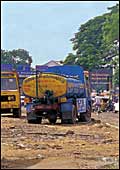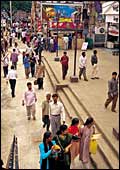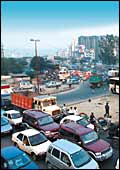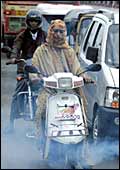 |
| The gravy train:
Supplying water is big business in Chennai |
CHENNAI: WATER
As this magazine goes to press, it
is raining in Chennai and everyone is smiling. To date (November
13), the city has received 577.8 mm of rainfall, and the almost
universal adoption of rain-water harvesting (mandated by the law
since April 2004) could mean that the city's water woes recede from
the insurmountable to the manageable. Still, despite all the rain
(Chennai has received 45 per cent of its yearly quota until now)
and the 180 million litres a day the city receives from the Veeranam
Lake, neither the residents nor the administration is particularly
sanguine: there still remains a shortfall of 690 million litres
a day. Desalination plants could be the answer in a city that fortunately
lies on the coast. The world's largest desalination plant at Ashkelon
in Israel produces potable water at a cost of around Rs 25 for 1,000
litres. The average middle-class household in Chennai currently
spends around Rs 800 a month for around 12,000 litres. The economics
are in favour of desalination, but with private water suppliers
(they supply water in tanker-loads) boasting powerful lobbies within
both the main political parties in the state, it is unlikely Chennai
will go the desalination-way anytime soon.
-Nitya Varadarajan
 |
| Like rabbits: Too
many people... that's Bangalore's problem |
BANGALORE: POPULATION
In 1991, Bangalore's population stood
at 4.5 million; today, estimates put the number at over 7 million.
"No one anticipated this kind of growth," says the city's
outgoing mayor P.R. Ramesh. "Any city would be hard-pressed
to cope (with this kind of growth)." Much of this growth in
population can be attributed, directly or indirectly, to the city's
1,200 it companies. There are 1.73 lakh tech-workers and their families
in the city, the labourers employed by developers catering to the
growing demand for commercial and residential real-estate space,
and the unskilled migrants from other parts of the state, even from
other states, pouring into Bangalore to fill positions as hired
help. Then, there is the mushrooming number of retail establishments
opportunistically hoping to make a quick buck from all that discretionary
income floating around. "The Mumbai-isation of Bangalore has
started," rues Hanumane Gowda, a long-time resident of the
city. "Slums have become a common sight and the quality of
life has definitely become worse." Only, Mumbai has managed
to cope with being the centre of India's old economy businesses.
Bangalore, which desperately wants to be the capital of the country's
knowledge industry, has flattered only to deceive.
-Venkatesha Babu
GURGAON: PUBLIC TRANSPORT
 |
| Spot the bus?:
Nor can those dependant on public transport in Gurgaon |
If you can afford to buy a house for
Rs 30 lakh, surely you can afford a few cars." That is the
response of an official of the Gurgaon administration to a query
on the lack of public transportation within Gurgaon, and between
the satellite and Delhi. Indeed, if you live in Gurgaon, work in
Delhi and do not own a car, life could be hell. The options include:
a) hitching a ride on an intra-state bus, typically one plying between
Delhi and Jaipur; b) hitching a ride on an intra-state bus, typically
one plying between Delhi and Jaipur; and c) hitching a ride on an
intra-state bus, typically one plying between Delhi and Jaipur.
Thus, while a soon-to-be-completed expressway will make life a whole
lot easier for car-owners, other residents of the city have to wait
for the Delhi Metro to extend to Gurgaon, a project that could take
quite some time (this magazine's estimate is: well beyond 2010).
And as far as travelling within the city is concerned (say, a trip
to the nearest shopping mall) residents have to make do with rickety
auto-rickshaws or human-powered pedal rickshaws. Then, that could
be a better option to driving down in your car and spending the
better part of an hour hunting for parking space.
-Kushan Mitra
 |
| Breathless: Air
pollution is now the biggest bane of Hyderabad |
HYDERABAD: AIR POLLUTION
In 1995, the quality of air in Hyderabad,
then seen as one of India's hottest cities for business, was better
than the standard listed by World Health Organisation. With 90 micrograms
of Respirable Suspended Particulate Matter (rspm, the main cause
of lung cancer) per one cubic metre of air as against the who standard
of 100, the city's air was as pure as one could expect a city's
to be. Today, the figure is nearly double that, courtesy a low road-share
to city-space ratio, rampant fuel-adulteration, and lax fuel-testing
norms (for instance, diesel vehicles are tested only for smoke,
not the presence of poly-aromatic compounds such as benzene, the
main cause of cancer and cardiac ailments, in the exhaust). With
no laws mandating the conversion of commercial vehicles to CNG (compressed
natural gas) and the retirement of vehicles that are more than 15
years old-Delhi and Mumbai have such laws, courtesy a Supreme Court
order-a mere 4,000 of Hyderabad's 64,000 auto-rickshaws have converted
to cleaner fuel (LPG, liquified petroleum gas, in this case). "There
is a proposal to impose a sort of green tax on polluting vehicles,"
says Tishya Chatterjee, Principal Secretary to the Government in
the Environment and Forests department. Then, with the testing methodology
flawed, that will take the city nowhere.
-E. Kumar Sharma
PUNE: TRAFFIC
 |
| Nowhere to go:
Pune's 1.2 million vehicles battle is out for road space every
day |
In what must surely be one of those
urban ironies that have become all too common, Pune, a city that
has contributed to the great Indian automotive revolution-Tata Motors,
Bajaj, Kinetic and a clutch of well-known auto-component makers
such as Bharat Forge and Cummins are based here-finds itself in
the midst of a traffic-management crisis that threatens to cripple
it. The statistics, as laid out by the Pune Traffic and Transportation
Forum (PTTF), are frightening: Pune has 1.2 million vehicles; Mumbai,
1 million. The commuting time during peak hours has more than doubled
in the past decade. In the same period, there has been a 30 per
cent increase in ailments stemming from vehicular pollution. And
a recent World Bank Report lists Pune as the fifth-most polluted
city in Asia. "The number one bottleneck is transportation,"
says Baba Kalyani, Chairman, Bharat Forge. The city's Municipal
Commisioner Nitin Kareer agrees, and says an integrated road development
scheme (it costs Rs 1,500 crore) that involves the widening of roads
and the construction of flyovers will help address the problem.
PTTF-member Sujit Patwardhan isn't impressed. "An increase
in road-length is not the solution," he says. "The added
capacity will become inadequate over time; why cannot we create
powerful magnets for living, shopping, and working in the suburbs?".
Whatever it wants to do, Pune better do it soon.
-Priya Srinivasan
|
